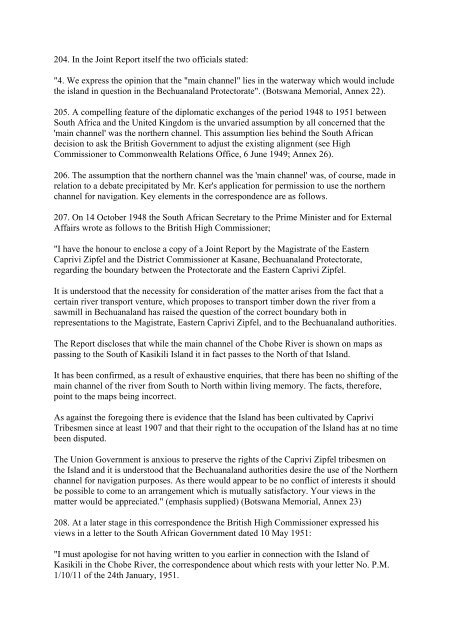botswana/namibia - Cour international de Justice
botswana/namibia - Cour international de Justice
botswana/namibia - Cour international de Justice
You also want an ePaper? Increase the reach of your titles
YUMPU automatically turns print PDFs into web optimized ePapers that Google loves.
204. In the Joint Report itself the two officials stated:<br />
"4. We express the opinion that the "main channel" lies in the waterway which would inclu<strong>de</strong><br />
the island in question in the Bechuanaland Protectorate". (Botswana Memorial, Annex 22).<br />
205. A compelling feature of the diplomatic exchanges of the period 1948 to 1951 between<br />
South Africa and the United Kingdom is the unvaried assumption by all concerned that the<br />
'main channel' was the northern channel. This assumption lies behind the South African<br />
<strong>de</strong>cision to ask the British Government to adjust the existing alignment (see High<br />
Commissioner to Commonwealth Relations Office, 6 June 1949; Annex 26).<br />
206. The assumption that the northern channel was the 'main channel' was, of course, ma<strong>de</strong> in<br />
relation to a <strong>de</strong>bate precipitated by Mr. Ker's application for permission to use the northern<br />
channel for navigation. Key elements in the correspon<strong>de</strong>nce are as follows.<br />
207. On 14 October 1948 the South African Secretary to the Prime Minister and for External<br />
Affairs wrote as follows to the British High Commissioner;<br />
"I have the honour to enclose a copy of a Joint Report by the Magistrate of the Eastern<br />
Caprivi Zipfel and the District Commissioner at Kasane, Bechuanaland Protectorate,<br />
regarding the boundary between the Protectorate and the Eastern Caprivi Zipfel.<br />
It is un<strong>de</strong>rstood that the necessity for consi<strong>de</strong>ration of the matter arises from the fact that a<br />
certain river transport venture, which proposes to transport timber down the river from a<br />
sawmill in Bechuanaland has raised the question of the correct boundary both in<br />
representations to the Magistrate, Eastern Caprivi Zipfel, and to the Bechuanaland authorities.<br />
The Report discloses that while the main channel of the Chobe River is shown on maps as<br />
passing to the South of Kasikili Island it in fact passes to the North of that Island.<br />
It has been confirmed, as a result of exhaustive enquiries, that there has been no shifting of the<br />
main channel of the river from South to North within living memory. The facts, therefore,<br />
point to the maps being incorrect.<br />
As against the foregoing there is evi<strong>de</strong>nce that the Island has been cultivated by Caprivi<br />
Tribesmen since at least 1907 and that their right to the occupation of the Island has at no time<br />
been disputed.<br />
The Union Government is anxious to preserve the rights of the Caprivi Zipfel tribesmen on<br />
the Island and it is un<strong>de</strong>rstood that the Bechuanaland authorities <strong>de</strong>sire the use of the Northern<br />
channel for navigation purposes. As there would appear to be no conflict of interests it should<br />
be possible to come to an arrangement which is mutually satisfactory. Your views in the<br />
matter would be appreciated." (emphasis supplied) (Botswana Memorial, Annex 23)<br />
208. At a later stage in this correspon<strong>de</strong>nce the British High Commissioner expressed his<br />
views in a letter to the South African Government dated 10 May 1951:<br />
"I must apologise for not having written to you earlier in connection with the Island of<br />
Kasikili in the Chobe River, the correspon<strong>de</strong>nce about which rests with your letter No. P.M.<br />
1/10/11 of the 24th January, 1951.

















